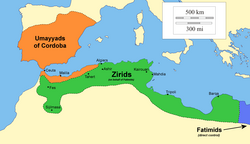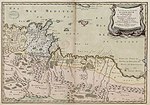
Back Zirí AN زيريون Arabic Zirilər sülaləsi Azerbaijani زیریلر سولالهسی AZB Зириди Bulgarian Zírida Catalan Zirídovci Czech Ziriden German Ziridoj Esperanto Ziríes Spanish
Zirid dynasty الزيريون | |||||||||||||||
|---|---|---|---|---|---|---|---|---|---|---|---|---|---|---|---|
| 972–1148 | |||||||||||||||
 Maximum extent of Zirid control c. 980 | |||||||||||||||
| Status | Vassal state of the Fatimid Caliphate (972–c. 1048) Nominal vassal of the Abbasid Caliphate (c. 1048–1148) | ||||||||||||||
| Capital | 'Ashir (936–1014) al-Mansuriyya (972–1057) Mahdia (1057–1148)[1][2][3][4] | ||||||||||||||
| Common languages | Berber (primary), Maghrebi Arabic, African Latin, Hebrew | ||||||||||||||
| Religion | Islam (Shia Islam, Sunni, Ibadi), Christianity (Roman Catholicism), Judaism | ||||||||||||||
| Government | Monarchy (Emirate) | ||||||||||||||
| Emir | |||||||||||||||
• 973–984 | Buluggin ibn Ziri | ||||||||||||||
• 1121–1148 | Al-Hassan ibn Ali | ||||||||||||||
| History | |||||||||||||||
• Established | 972 | ||||||||||||||
• Disestablished | 1148 | ||||||||||||||
| Currency | Dinar | ||||||||||||||
| |||||||||||||||
| History of Algeria |
|---|
 |
| History of Tunisia |
|---|
 |
|
|
The Zirid dynasty (Arabic: الزيريون, romanized: az-zīriyyūn), Banu Ziri (Arabic: بنو زيري, romanized: banū zīrī), was a Sanhaja Berber dynasty from what is now Algeria which ruled the central Maghreb from 972 to 1014 and Ifriqiya (eastern Maghreb) from 972 to 1148.[2][5]
Descendants of Ziri ibn Manad, a military leader of the Fatimid Caliphate and the eponymous founder of the dynasty, the Zirids were emirs who ruled in the name of the Fatimids. The Zirids gradually established their autonomy in Ifriqiya through military conquest until officially breaking with the Fatimids in the mid-11th century. The rule of the Zirid emirs opened the way to a period in North African history where political power was held by Berber dynasties such as the Almoravid dynasty, Almohad Caliphate, Zayyanid dynasty, Marinid Sultanate and Hafsid dynasty.[6]
Under Buluggin ibn Ziri the Zirids extended their control westwards and briefly occupied Fez and much of present-day Morocco after 980, but encountered resistance from the local Zenata Berbers who gave their allegiance to the Caliphate of Cordoba.[4][7][8][9] To the east, Zirid control was extended over Tripolitania after 978[10] and as far as Ajdabiya (in present-day Libya).[11] One member of the dynastic family, Zawi ibn Ziri, revolted and fled to al-Andalus, eventually founding the Taifa of Granada in 1013, after the collapse of the Caliphate of Cordoba.[12] Another branch of the Zirids, the Hammadids, broke away from the main branch after various internal disputes and took control of the territories of the central Maghreb after 1015.[13] The main branch of the Zirids, also called the Badisides,[14] occupied only Ifriqiya between 1048 and 1148.[3] They were based in Kairouan until 1057, when they moved the capital to Mahdia on the coast.[15] The Zirids of Ifriqiya also intervened in Sicily during the 11th century, as the Kalbids, the dynasty who governed the island on behalf of the Fatimids, fell into disorder.[16]
The Zirids of Granada surrendered to the Almoravids in 1090,[17] but the Badicides and the Hammadids remained independent during this time. Sometime between 1041 and 1051 the Zirid ruler al-Mu'izz ibn Badis renounced the Fatimid Caliphs and recognized the Sunni Muslim Abbasid Caliphate.[18] In retaliation, the Fatimids instigated the migration of the Banu Hilal tribe to the Maghreb, dealing a serious blow to Zirid power in Ifriqiya.[19][20] In the 12th century, the Hilalian invasions combined with the attacks of the Normans of Sicily along the coast further weakened Zirid power. The last Zirid ruler, al-Hasan, surrendered Mahdia to the Normans in 1148, thus ending independent Zirid rule.[20] The Almohad Caliphate conquered the central Maghreb and Ifriqiya by 1160, ending the Hammadid dynasty in turn and finally unifying the whole of the Maghreb.[7][21]
- ^ Phillip C. Naylor (15 January 2015). North Africa, Revised Edition: A History from Antiquity to the Present. University of Texas Press. p. 84. ISBN 978-0-292-76190-2.
- ^ a b "Zirid Dynasty | Muslim dynasty". Encyclopædia Britannica. Archived from the original on 29 February 2020. Retrieved 27 November 2016.
- ^ a b Cite error: The named reference
:9was invoked but never defined (see the help page). - ^ a b Julien, Charles-André (1 January 1994). Histoire de l'Afrique du Nord: des origines à 1830 (in French). Payot. p. 295. ISBN 9782228887892.
- ^ "Qantara - Les Zirides et les Hammadides (972-1152)". www.qantara-med.org. Archived from the original on 3 March 2016. Retrieved 27 November 2016.
- ^ Hrbek, Ivan; Africa, Unesco International Scientific Committee for the Drafting of a General History of (1 January 1992). Africa from the Seventh to the Eleventh Century. J. Currey. p. 172. ISBN 9780852550939.
- ^ a b Meynier, Gilbert (1 January 2010). L'Algérie, coeur du Maghreb classique: de l'ouverture islamo-arabe au repli (698-1518) (in French). La Découverte. p. 158. ISBN 9782707152312.
- ^ Simon, Jacques (1 January 2011). L'Algérie au passé lointain: de Carthage à la régence d'Alger (in French). Harmattan. p. 165. ISBN 9782296139640.
- ^ Trudy Ring; Noelle Watson; Paul Schellinger (5 March 2014). Middle East and Africa: International Dictionary of Historic Places. Routledge. p. 36. ISBN 978-1-134-25986-1.
- ^ Abun-Nasr 1987, p. 67.
- ^ Fehérvári, Géza (2002). Excavations at Surt (Medinat Al-Sultan) Between 1977 and 1981. Department of Antiquities. p. 17. ISBN 978-1-900971-00-3.
- ^ Cite error: The named reference
:12was invoked but never defined (see the help page). - ^ Bosworth, Clifford Edmund (1996). "The Zirids and Hammadids". The New Islamic Dynasties: A Chronological and Genealogical Manual. Edinburgh University Press. pp. 35–36. ISBN 9780748696482.
- ^ Sénac, Philippe; Cressier, Patrice (2012). "Zirides, Badisides, et Hammadides". Histoire du Maghreb médiéval: VIIe-XIe siècle (in French). Armand Colin. ISBN 978-2-200-28342-1.
- ^ Abun-Nasr 1987, pp. 69–70.
- ^ Cite error: The named reference
:0524was invoked but never defined (see the help page). - ^ Bosworth, Clifford Edmund (1996). The New Islamic Dynasties: A Chronological and Genealogical Manual. Edinburgh University Press. p. 17. ISBN 9780748696482.
- ^ Abun-Nasr 1987, p. 68-69.
- ^ Abun-Nasr 1987, p. 69-70.
- ^ a b Tibi 2002, p. 514.
- ^ Baadj 2015, p. 56-57.
© MMXXIII Rich X Search. We shall prevail. All rights reserved. Rich X Search